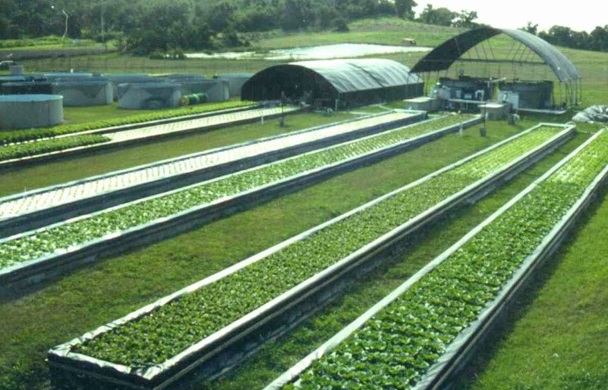Education
What is aquaponics?
Some believe the Aztec were first to engage in agricultural use of aquaponics, raising plants on floating islands in fish ponds.
Others refer to ancient Egypt. Either way, it is clear that aquaponics have ancient roots.
What is aquaponics?
Aquaponics is the simultaneous cultivation of plants and aquatic animals in a symbiotic environment where the animal waste by-products that accumulate in the water are used and filtered out by the plants as nutrients, after which the water is recirculated back to the animals. The system consists of two parts; one of them a traditional aquaculture system and traditional hydroponics system, and basically takes the waste by-products generated from aquaculture for use as the nutrient solution for hydroponics. The hydroponics portion of the system in turn acts as the filtration system to maintain water quality for aquaculture portion. Aquaponic systems vary in size from small indoor units to large commercial units. They can use fresh or salt water depending on the type of aquatic animal and vegetation.
Aquaponics, consists of two main parts with the aquaculture part for raising aquatic animals and the hydroponics part for growing plants. Aquatic effluents resulting from uneaten feed or raising animals like fish accumulates in water due to the closed system recirculation of most aquaculture systems. The effluent-rich water becomes toxic to the aquatic animal in high concentrations but these effluents are nutrients essential for plant growth.
Plants are grown with their roots immersed in the nutrient-rich effluent water similar to hydroponic systems. This enables them to utilize the nutrient-rich water and filter out the compounds toxic to the animals. The water coming from the aquaculture part of the system is first allowed to settle in order to remove solid wastes. This also allows time for nitrification of ammonia in the system into nitrates usable by the plants as well as oxygenation of the water. The plants in turn take up the nutrients, reducing or eliminating the water’s toxicity for the aquatic animal. The water, now clean and oxygenated, is returned to the aquatic animal environment and the cycle continues.
Aquaponic systems do not typically discharge or exchange water under normal operation. The system relies on the relationship between the animals and the plants to maintain a stable aquatic environment that experience a minimal of fluctuation in ambient nutrient and oxygen levels. Water is only added to replace water loss from absorption by the plants, evaporation into the air, or the removal of biomass such as settled solid wastes from the system.
The main input to the system other than water is the feed given to the aquatic animals.

